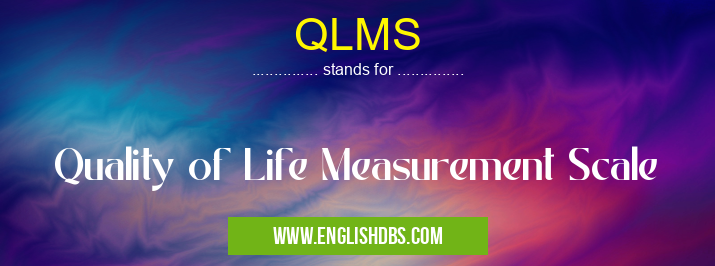What does QLMS mean in UNCLASSIFIED
QLMS stands for Quality of Life Measurement Scale. It is a tool used to assess the quality of life of individuals, typically in the context of healthcare and research. The QLMS measures various aspects of an individual's well-being, including physical health, psychological well-being, social functioning, and environmental factors.

QLMS meaning in Unclassified in Miscellaneous
QLMS mostly used in an acronym Unclassified in Category Miscellaneous that means Quality of Life Measurement Scale
Shorthand: QLMS,
Full Form: Quality of Life Measurement Scale
For more information of "Quality of Life Measurement Scale", see the section below.
Purpose of the QLMS
The QLMS is designed to provide a comprehensive evaluation of an individual's quality of life. It can be used for a variety of purposes, such as:
- Monitoring the progress of patients with chronic conditions
- Evaluating the effectiveness of healthcare interventions
- Identifying areas where an individual's quality of life can be improved
- Conducting research on factors that influence quality of life
How the QLMS Works
The QLMS typically consists of a series of questions that the individual is asked to answer. The questions cover a range of topics, including:
- Physical health (e.g., pain, mobility, energy levels)
- Psychological well-being (e.g., mood, anxiety, depression)
- Social functioning (e.g., relationships, social activities)
- Environmental factors (e.g., housing, financial security, access to healthcare)
The individual's responses to the questions are then scored and used to generate a composite score that reflects their overall quality of life.
Essential Questions and Answers on Quality of Life Measurement Scale in "MISCELLANEOUS»UNFILED"
What is the Quality of Life Measurement Scale (QLMS)?
The QLMS is a standardized tool used to assess the quality of life of individuals. It measures multiple dimensions of well-being, including physical, psychological, social, and environmental factors.
Who can use the QLMS?
The QLMS can be used by healthcare professionals, researchers, and individuals to assess the quality of life of patients, participants in clinical trials, or anyone interested in tracking their own well-being.
How is the QLMS administered?
The QLMS is typically administered as a self-report questionnaire, where individuals rate their perceptions or experiences on a Likert scale. It can be completed online, on paper, or through an interview.
What are the dimensions measured by the QLMS?
The standard QLMS includes 26 items that cover six dimensions of quality of life: physical well-being, psychological well-being, social relationships, environmental resources, occupational activities, and spiritual well-being.
How are the results of the QLMS interpreted?
The results of the QLMS are typically presented as a total score and subscores for each dimension. Higher scores indicate a better quality of life. The results can be used to identify areas where individuals may need support or intervention to improve their overall well-being.
What are the strengths of the QLMS?
The QLMS is a reliable and valid tool that has been widely used in research and clinical settings. It is easy to administer, provides a comprehensive assessment of quality of life, and is available in various languages and cultural adaptations.
Are there any limitations to the QLMS?
Like any self-report measure, the QLMS may be subject to response bias or social desirability effects. Additionally, the fixed response options may not capture the full range of experiences or cultural nuances of all individuals.
Final Words: The QLMS is a valuable tool for assessing the quality of life of individuals. It provides a comprehensive evaluation of various aspects of well-being, and can be used for a variety of purposes. By understanding the factors that influence quality of life, healthcare professionals and researchers can develop interventions and policies to improve the overall well-being of individuals.
